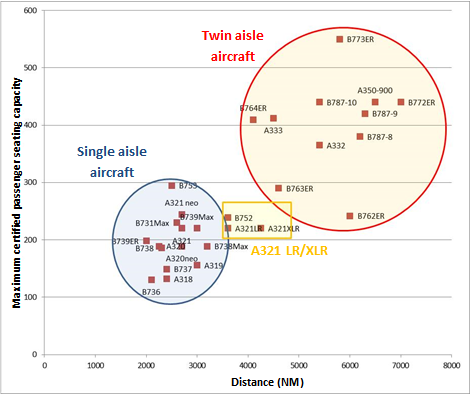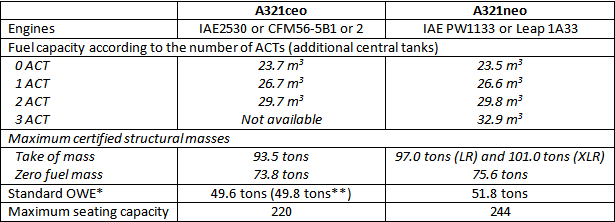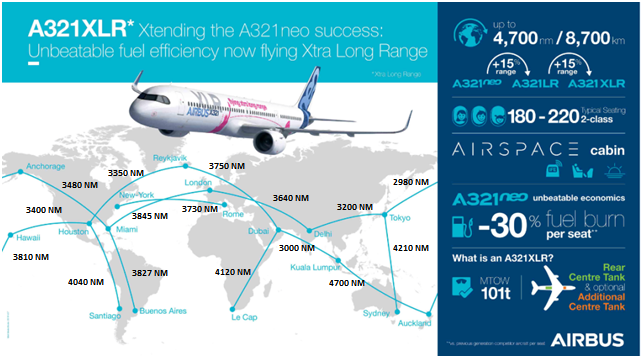During the last Paris Air Show, Airbus confirmed the launch of XLR version of the Airbus A321neo, upgrading to 101 tons its maximum certificated take-off weight (MTOW).
Airbus A321neo XLR is a version developped to fit with a niche market
This new version completes the single-aisle airplanes family, developed by Airbus for more than 30 years, which has two generations of aircraft to date:
- The original family is made with “Airbus ceo”. These aircraft, fit with CFM 56 or IAE 2500 engines, have seen slight improvements over time (engines a little more fuel-efficient, sharklets added at the wing tip)
- The second generation is made with “Airbus neo”. These airplanes have an increased maximum certified capacity (the A321neo can accommodate up to 244 passengers against 220 for the A321ceo) and are fit with Leap or Pure Power engines – manufactured respectively by CFM and Pratt & Whitney – which consume on average 17% less than those installed on the Airbus ceo
Progressively completed with long-haul aircraft – Airbus A330, A340, A380 and, more recently, A350 – the Airbus fleet, analysed according to the criteria of transportable payload and range, now equals Boeing’s one with the position of the A321neo XLR on the niche occupied only by the Boeing 757-200 since the late 70s.
Range with the maximum certified number of passengers with 15 kg hold baggage each, with no additional cargo, at long range cruise speed and with standard fuel reserves

Airbus A321neo XLR is one of the numerous versions proposed for this very flexible aircraft
The significant technological advantage reached with the engines fit to the neo family enables Airbus, on the one hand, to significantly improve the radius of action of family aircraft without major changes in the wing or fuselage, and on the other hand, to further promote the concept of versatility on the Airbus A321neo thanks to the following triple evolution:
- The possibilities offered in terms of fuel capacity have been supplemented with the option of a possible third ACT (central additional tank)
- New combinations of certified masses including increased maximum take-off weights are proposed (from 80 tonnes for aircraft to operate on short flights up to 101 tonnes). However, the mass in order of operation (MOE), that is to say without usable fuel and without commercial load, is slightly higher on the neo
- The maximum certified capacity of the aircraft is increased, in particular to meet the expectations of low-cost airlines. This densified capacity remains, however, at the expense of some of the space available for galleys (ovens, trolleys, etc.).

**: Aircraft with sharklets
Source: Airport Planning Manual Airbus A321
AIrbus A321neo XLR is fully adapted to the launch of long haul routes with limited passenger traffic
In its heaviest version, the Airbus A321neo XLR fit with 3 ACT can carry 220 passengers with 15 kg of checked baggage each over a distance of around 4200 NM (about 700 NM more than with the LR version) – considering standard fuel reserves – against nearly 2800 NM for the Airbus A321ceo fit with sharklets and two ACTs.
Over such distances, the Airbus A321neo offers real opportunities to launch new long-haul routes where potential traffic does not economically justify twin-aisle aircraft operations.

In its lighter versions (maximum take-off weight of 89 tons for example), the Airbus A321neo without ACT can carry 244 passengers with 10 kg of checked baggage each over 2000 NM, and thus meets the needs of low-cost airlines with a low operating cost per offered seat.
For example, the Airbus A321neo (244 seats) fuel flow per offered seat is about 38% lower than that of the Boeing 757-200 (239 seats). The Boeing 737 MAX10 (230 seats) is the only single-aisle aircraft theoretically likely to approach the performance of the A321neo.
In short, with the A321neo, Airbus seems to have reached its goal of offering a truly versatile aircraft, suitable for legacy or low-cost airlines operations, on medium and long-haul (with LR and, especially, XLR versions).
As the enviable backlog at June 30, 2019 shows, the bet seems successful: 2,493 aircraft are still to be delivered to 61 companies (source: Airbus), of which approximately 250 for the XLR version, including 50 for American Airlines and 36 for Qantas.
Is XLR the missing version to turn very polyvalent Airbus A321neo into “ideal” aircraft ?
As a result, should this aircraft be considered the ideal aircraft? Maybe not on all routes, due to the limited holds volume available when three ACTs are fit:

**: calculated with the assumption of luggage and cargo density equal to 160 kg/m3
On long-haul networks, holds capacity for cargo in addition to checked baggage remains very low, even when the seating configuration is not very densified. On routes where the average mass of luggage per passenger is high – as between Europe and Sub-Saharan Africa – the operation of A321neo can reasonably be considered with only a maximum of two ACTs, which reduces slightly the potential network.
The restriction induced by the reduced holds volume when 3 ACTs are fit therefore has an impact, which however remains limited when compared to the range of A321neo possible operations, as it only concerns the following routes
- Those which distance exceeds 4,200 NM
- Those on which the passenger and/or freight traffic is huge
The A321neo in the -XLR version should thus enable the launch of numerous new routes on which traffic flows are too low to justify the use of twin-aisle aircraft, including to airports from which no long-haul route is presently operated.



Laisser un commentaire